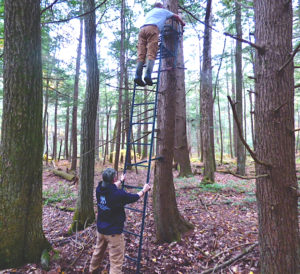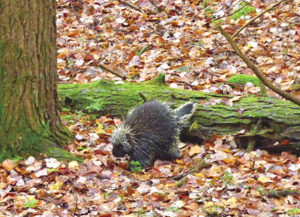
HOLDEN — I’m sitting in a tree stand 15 feet off the ground. I’ve been here since 6 a.m. and it’s now 8:45. I believe I saw a deer at about 6:30, but it was at a distance and too dark to know for sure.
“Every good hunter mistakes a stump for a deer twice a trip,” my friend Jake McGrath would later tell me.
He’s sitting in a tree stand adjacent to mine and just a few feet higher.
Suddenly I see something move behind a tree roughly 15 yards away. After nearly three hours, this is the most action we’ve had. I lock my eyes on the tree. I’m supposed to wait until I see the animal so I can signal to Jake to turn his body and get eyes on the potential target. This could be the moment. The creature finally moves from behind the tree. It’s a porcupine.
The animal waddles along underneath us and then swiftly climbs a tree. We get down off our stands and head in for breakfast.
We’ll do this climbing and waiting again tonight and the next morning, without seeing much more than a few squirrels.

I have accompanied Jake and his father, Jim McGrath, on a two-night mid-October hunting trip from their home in Eastham to their family cabin in Holden, north of Worcester.
This is my first hunting experience, and I am here purely for observation. It’s a trip that has increased my respect for the art of the hunt and a sport that rarely rewards its participants.
Hunting With a Bow
Deer hunting season in Massachusetts is divided up according to the weapons used. Bow season runs from Oct. 7 to Nov. 30; shotgun season is Dec. 2 to 14; and primitive arms season is Dec. 16 to 31. Fall turkey hunting season runs from Oct. 21 to Nov. 2.
I learn that there isn’t necessarily any rivalry between bow hunters and gun hunters. Jake and Jim do both. On this trip, we’ll make three deer hunts and one gun hunt for turkeys.
“Bow hunting is a discipline you really have to practice a lot to get good at,” says Jim. “Archery is my favorite season.”
“There’s a lot more preparation in it,” says Jake. “People who bow hunt are generally more enthusiastic about hunting.”
There’s a month-long period of practice for bow hunters before the season starts. The McGraths set up targets in their back yard to develop accuracy. They prepare their equipment and gather warm clothing before heading out for a hunt.
“It’s about muscle memory,” Jim says. You practice so when the moment shows up you’re ready, he explains.
That moment doesn’t happen very often. Deer are elusive and have keen senses of smell and hearing — not an easy opponent.
Our days in the woods
We spend the first day scouting the woods near their cabin. Jim and Jake look for signs like tracks, poop, antler rubs on trees, or scrapes in the ground.
They explain to me that bucks will sometimes rub their antlers on trees while digging their hooves in the ground.
We carry a couple of tree stands out to a spot near some of these indicators and tie them to a wide tree for Jake and me to sit in the following morning.

A tree stand is essentially a ladder with a seat at the top, tied to a tree. Dressed in camo, bow hunters climb the ladder, sit in the seat, hook their bow to the tree, and wait.
Jake adjusts my expectations. He tells me it’s easy to get discouraged when you don’t see anything, but just seeing a deer in the wild is worth the wait.
It’s best to hunt at dawn and dusk. The hours when deer are roaming and you can see.
We set up Jim’s stand in another part of the woods. He has no luck at his position either that first morning.
We spend the late morning riding four-wheelers along wooded trails looking for other areas to hunt. That afternoon we go for a long hike in search of turkeys but come up with nothing. We head back to home base to rest before that night’s deer hunt.
We’re back on our stands by 4:30 p.m. and stay until after sundown. Again, no luck. Dinner and sleep follow. The next morning we’re on our stands by 6 a.m. for one last hunt.
In all I spend about nine hours sitting silently on a tree stand in the middle of the woods. It feels like a different world. I hear only the sound of leaves falling and birds chirping. My eyes begin to play tricks on me. Every leaf that falls sounds like a footstep.
I begin to see that hunting is a sport like any other. You need a game plan based on scouting the opponent. Then you need to try and carry out that game plan strategically.
Scoring chances don’t come often, if they come at all. But when a scoring opportunity does come, hunters must take advantage by hitting their shot.
Hunting with a purpose
Before we leave, I watch Jim skin and butcher a deer he got in New York a few days earlier. It has been aging in a cool barn nearby.
The McGraths tell me the key is to aim your weapon at the “boiler room,” where vitals like the lungs and heart are. That way the deer won’t be able to run far after being struck. Deer usually take off after being hit. It’s important to see which direction they run and follow the blood trail they leave in order to find them.
“Shot placement is really important,” Jim says.
There is enough meat on this deer to feed the McGrath family 15 to 20 meals. The McGraths are hunter-harvesters. For them, hunting is a humane and healthy way of eating meat compared to the way industrial livestock operations treat animals that are later sold at supermarkets.
“You know what they’re eating,” Jim says of the deer in the wild.
They also use the deerskins for blankets or give them to people who make clothing or boots. Although they take pride in being self-sufficient, the McGraths accept the fact that some people aren’t fond of hunting.
“If you don’t like hunting, that’s fine,” says Jake. “But don’t knock it if you don’t know anything about it or the people who do it.”
There is more practice, preparation, hiking, and patience than killing to this sport. Now I know.
